

Compact Muon Solenoid
LHC, CERN
| CMS-PAS-HIG-15-008 | ||
| Search for $ \mathrm{ t \bar{t} H } $ production in multilepton final states at $\sqrt{s} =$ 13 TeV | ||
| CMS Collaboration | ||
| March 2016 | ||
|
Abstract:
A search for the standard model Higgs boson produced in association with a top quark pair is presented. Data collected by the CMS experiment in pp collisions at a center of mass energy of $\sqrt{s}=$ 13 TeV and corresponding to an integrated luminosity of 2.3 fb$^{-1}$ are used. The analysis targets the $\mathrm{WW}^{*}$, $\mathrm{ZZ}^{*}$ and $\tau\tau$ decay channels of the Higgs boson by selecting final states with two same-sign leptons or more than three leptons, produced in association with b jets. The signal strength is measured to be 0.6$^{+1.4}_{-1.1}$ times the standard model expectation. The observed 95% confidence level upper limit on the $ \mathrm{t} \overline{\mathrm{t}} \mathrm{H} $ production cross section is 3.3 times the standard model expectation, compared to the 2.6 expected in absence of a signal. The combination of ttH results with CMS data at 13 TeV is summarized at this url. | ||
| Links: CDS record (PDF) ; inSPIRE record ; CADI line (restricted) ; | ||
| Figures | |
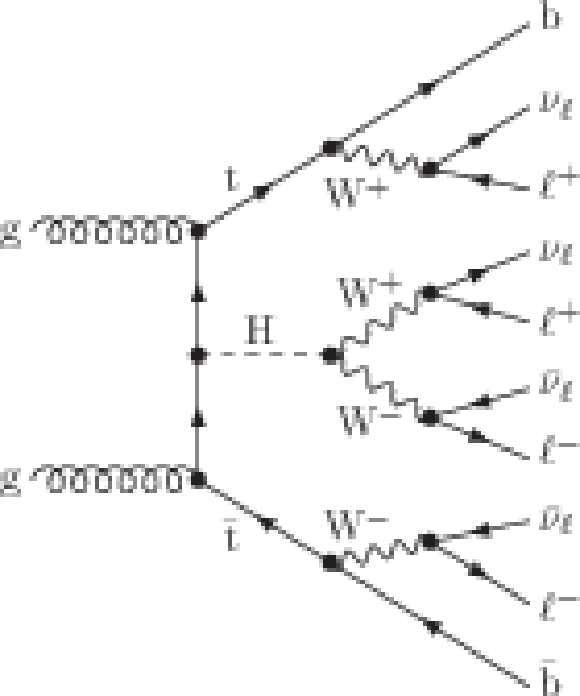
png pdf |
Figure 1-a:
Feynman diagrams for $ { {\mathrm{ t \bar{t} } } \mathrm{ H } } $ production at pp colliders, with the Higgs boson decaying to $\mathrm {WW}^{*}$, $\mathrm {ZZ}^{*}$, and $\tau \tau $ (from a to c). They represent examples of final states with four leptons, three leptons, and two same-sign leptons, respectively. |

png pdf |
Figure 1-b:
Feynman diagrams for $ { {\mathrm{ t \bar{t} } } \mathrm{ H } } $ production at pp colliders, with the Higgs boson decaying to $\mathrm {WW}^{*}$, $\mathrm {ZZ}^{*}$, and $\tau \tau $ (from a to c). They represent examples of final states with four leptons, three leptons, and two same-sign leptons, respectively. |
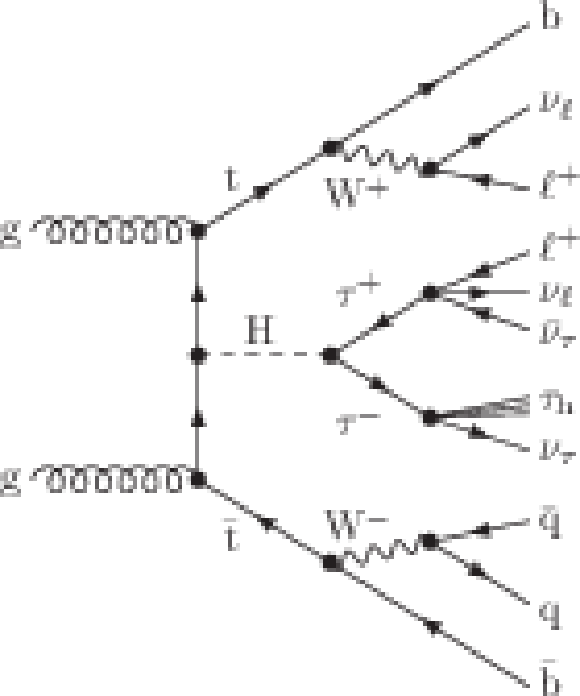
png pdf |
Figure 1-c:
Feynman diagrams for $ { {\mathrm{ t \bar{t} } } \mathrm{ H } } $ production at pp colliders, with the Higgs boson decaying to $\mathrm {WW}^{*}$, $\mathrm {ZZ}^{*}$, and $\tau \tau $ (from a to c). They represent examples of final states with four leptons, three leptons, and two same-sign leptons, respectively. |

png pdf |
Figure 2-a:
a,b,c: number of selected jets in the same-sign $\mu \mu $, $\mathrm{e} \mathrm{e} $, and $\mathrm{e} \mu $ channels. d,e,f: distributions of the BDT kinematic discriminants and result of their combination in the bins used for signal extraction, for the two lepton same-sign selection inclusive in lepton flavor. Pre-fit distributions are shown. Uncertainties are statistical only. |
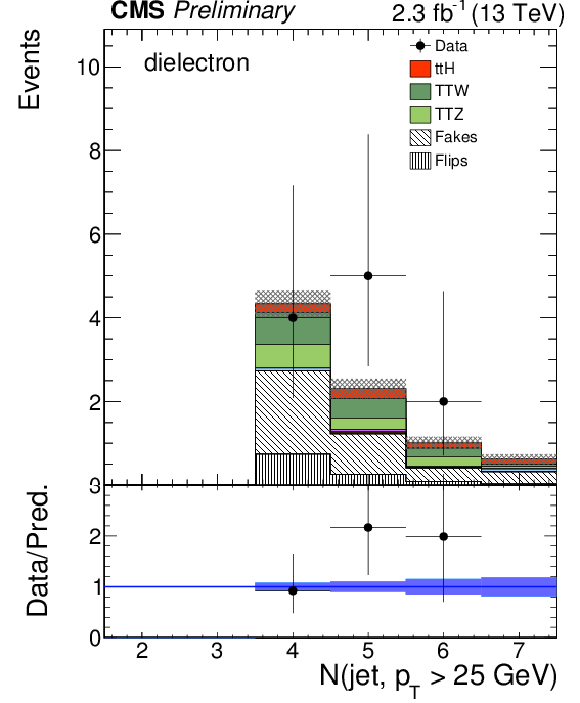
png pdf |
Figure 2-b:
a,b,c: number of selected jets in the same-sign $\mu \mu $, $\mathrm{e} \mathrm{e} $, and $\mathrm{e} \mu $ channels. d,e,f: distributions of the BDT kinematic discriminants and result of their combination in the bins used for signal extraction, for the two lepton same-sign selection inclusive in lepton flavor. Pre-fit distributions are shown. Uncertainties are statistical only. |
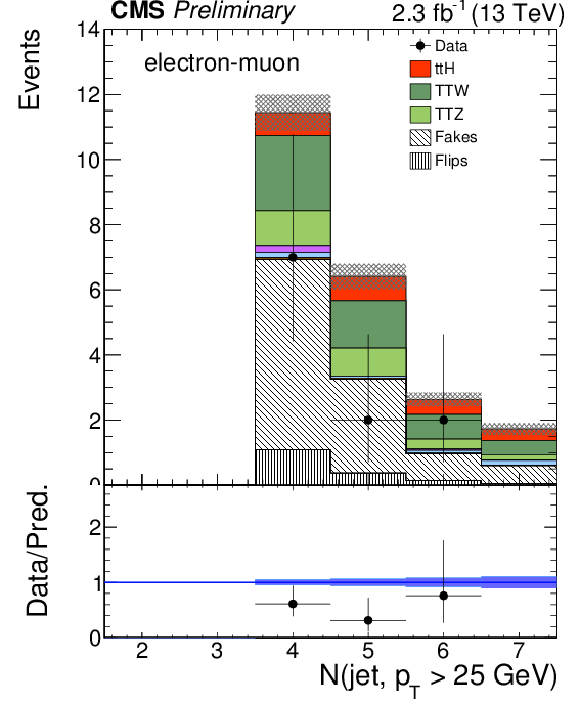
png pdf |
Figure 2-c:
a,b,c: number of selected jets in the same-sign $\mu \mu $, $\mathrm{e} \mathrm{e} $, and $\mathrm{e} \mu $ channels. d,e,f: distributions of the BDT kinematic discriminants and result of their combination in the bins used for signal extraction, for the two lepton same-sign selection inclusive in lepton flavor. Pre-fit distributions are shown. Uncertainties are statistical only. |
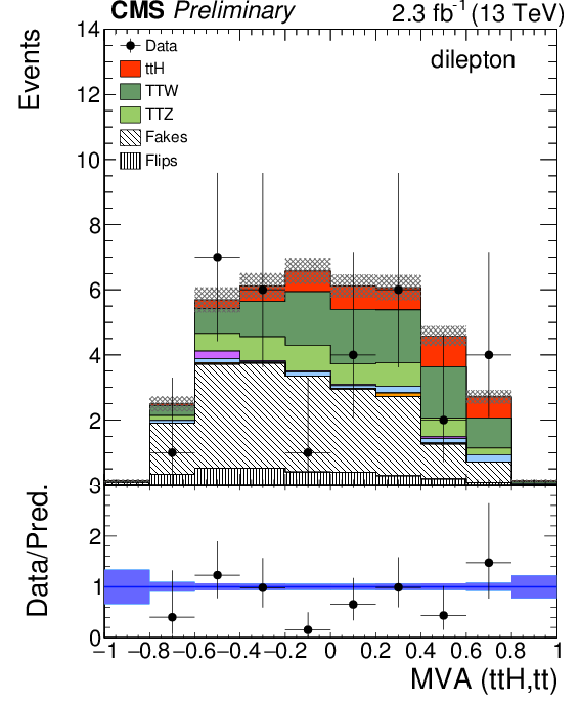
png pdf |
Figure 2-d:
a,b,c: number of selected jets in the same-sign $\mu \mu $, $\mathrm{e} \mathrm{e} $, and $\mathrm{e} \mu $ channels. d,e,f: distributions of the BDT kinematic discriminants and result of their combination in the bins used for signal extraction, for the two lepton same-sign selection inclusive in lepton flavor. Pre-fit distributions are shown. Uncertainties are statistical only. |

png pdf |
Figure 2-e:
a,b,c: number of selected jets in the same-sign $\mu \mu $, $\mathrm{e} \mathrm{e} $, and $\mathrm{e} \mu $ channels. d,e,f: distributions of the BDT kinematic discriminants and result of their combination in the bins used for signal extraction, for the two lepton same-sign selection inclusive in lepton flavor. Pre-fit distributions are shown. Uncertainties are statistical only. |

png pdf |
Figure 2-f:
a,b,c: number of selected jets in the same-sign $\mu \mu $, $\mathrm{e} \mathrm{e} $, and $\mathrm{e} \mu $ channels. d,e,f: distributions of the BDT kinematic discriminants and result of their combination in the bins used for signal extraction, for the two lepton same-sign selection inclusive in lepton flavor. Pre-fit distributions are shown. Uncertainties are statistical only. |
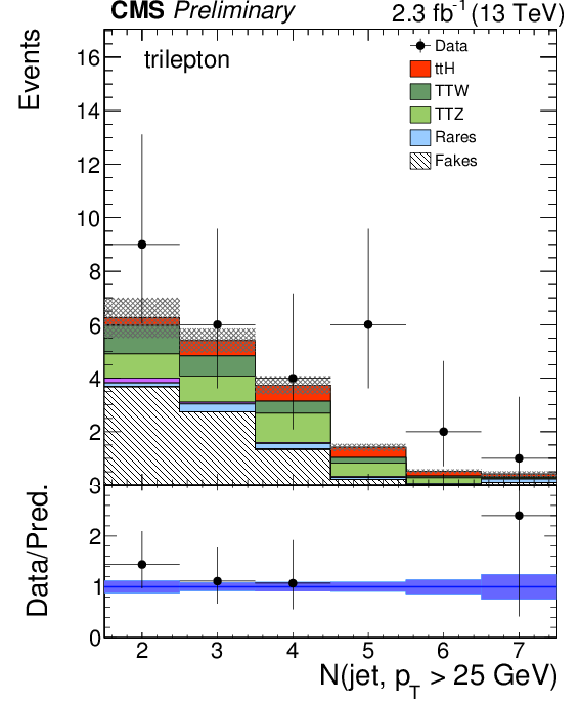
png pdf |
Figure 3-a:
Number of selected jets, distributions of the BDT kinematic discriminants and result of their combination in the bins used for signal extraction, for the three-lepton channel. Pre-fit distributions are shown. Uncertainties are statistical only. |
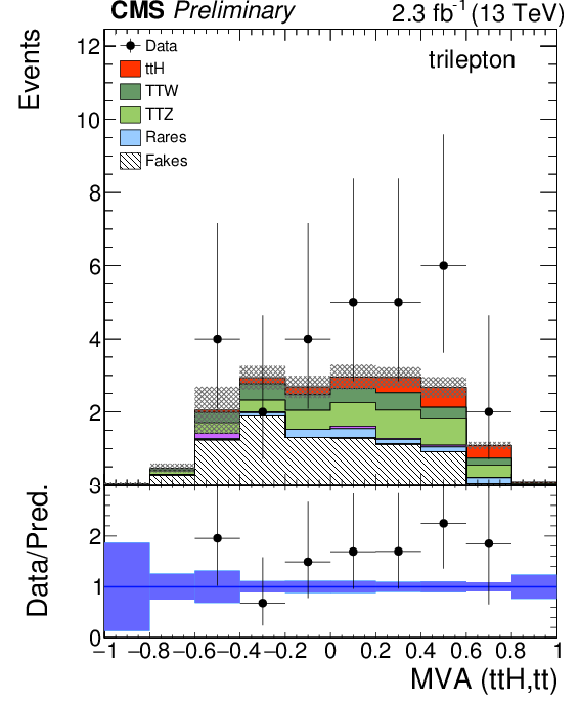
png pdf |
Figure 3-b:
Number of selected jets, distributions of the BDT kinematic discriminants and result of their combination in the bins used for signal extraction, for the three-lepton channel. Pre-fit distributions are shown. Uncertainties are statistical only. |
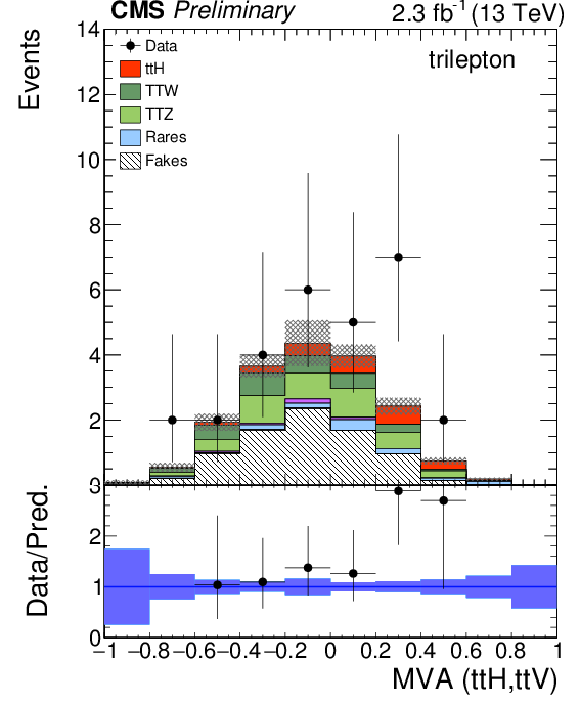
png pdf |
Figure 3-c:
Number of selected jets, distributions of the BDT kinematic discriminants and result of their combination in the bins used for signal extraction, for the three-lepton channel. Pre-fit distributions are shown. Uncertainties are statistical only. |
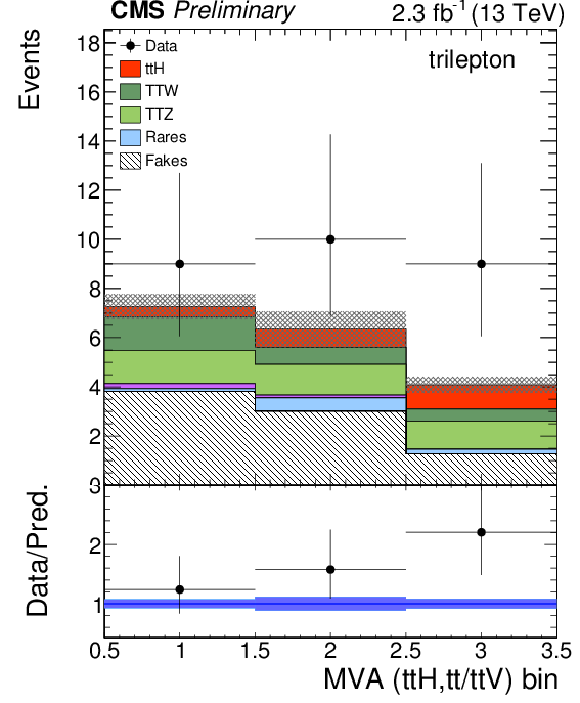
png pdf |
Figure 3-d:
Number of selected jets, distributions of the BDT kinematic discriminants and result of their combination in the bins used for signal extraction, for the three-lepton channel. Pre-fit distributions are shown. Uncertainties are statistical only. |
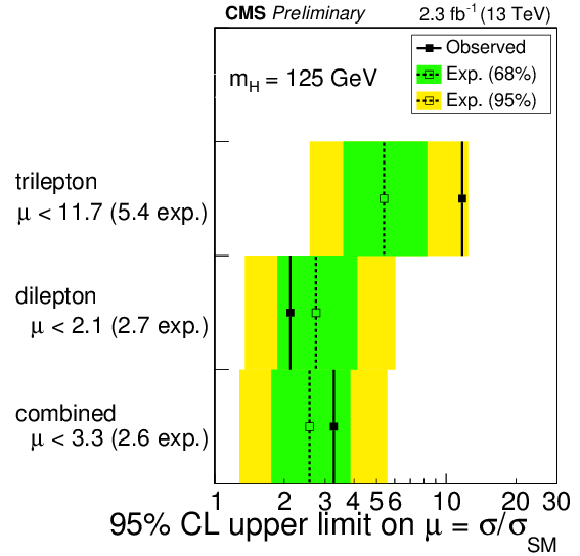
png pdf |
Figure 4-a:
a: asymptotic 95% CL upper limits on the signal strength parameter. b: best fit of the signal strength parameter. |
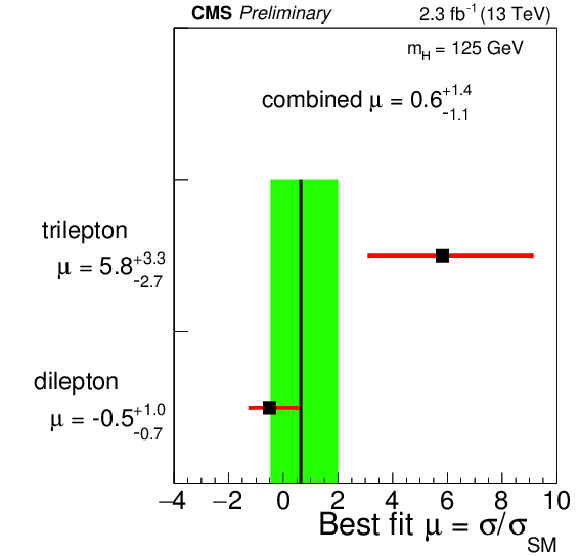
png pdf |
Figure 4-b:
a: asymptotic 95% CL upper limits on the signal strength parameter. b: best fit of the signal strength parameter. |
| Tables | |
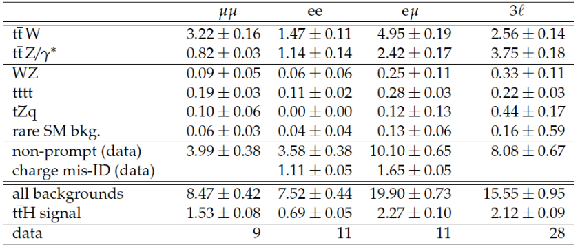
png pdf |
Table 1:
Expected and observed yields after the selection in 2lss and three-lepton final states. The rare SM backgrounds include ${\mathrm{Z} } {\mathrm{Z} } $, $\mathrm{W} ^\pm \mathrm{W} ^\pm \mathrm {qq}$, $\mathrm{W} \mathrm{W} $ produced in double-parton interactions, and triboson production. Uncertainties are statistical only. The backgrounds from non-prompt leptons and charge flips are extracted from data. |

png pdf |
Table 2:
Asymptotic 95% CL upper limits on the signal strength parameter. |

png pdf |
Table 3:
Best fit of the signal strength parameter. |

|
Compact Muon Solenoid LHC, CERN |

|

|

|

|

|

|